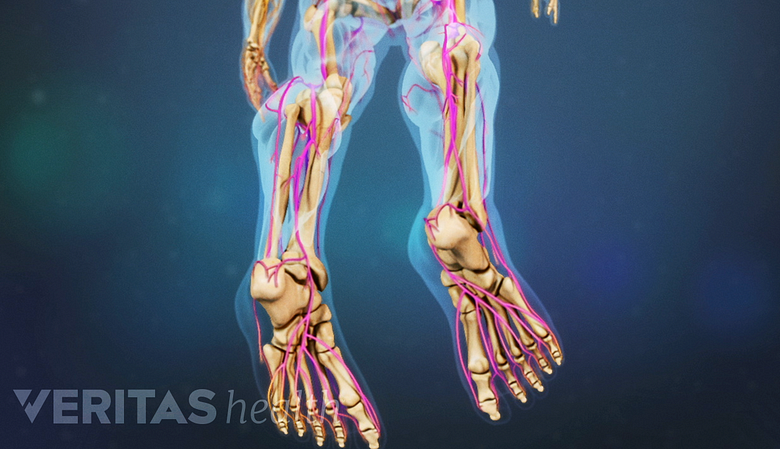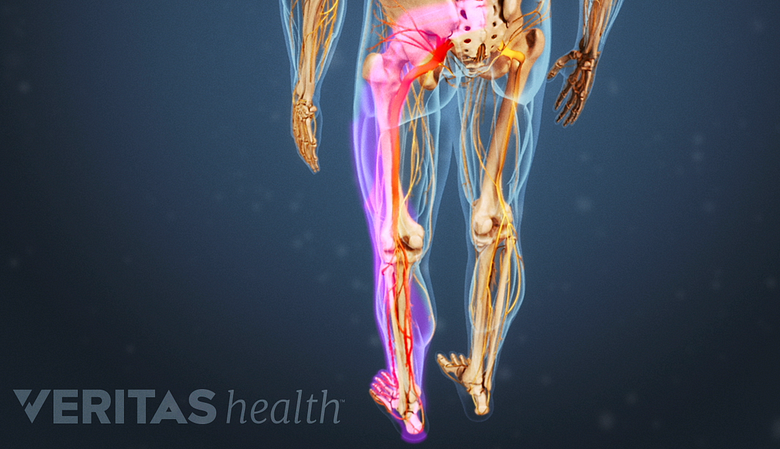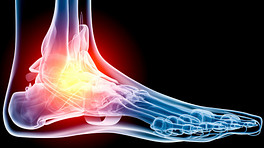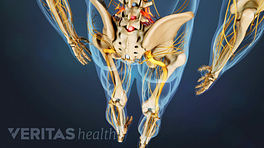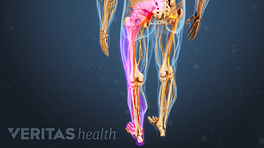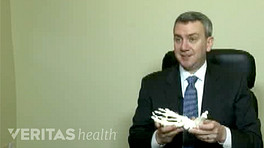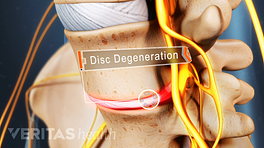The symptoms of foot drop may occur gradually or appear suddenly, making it difficult to stand, walk, or lift the affected foot. The walking pattern or gait of the person typically changes to compensate for the weakness in the foot muscles.
The symptoms of foot drop vary depending on the type and severity of the underlying condition. A few symptoms and warning signs of foot drop are discussed below.
In This Article:
- What Is Foot Drop?
- Foot Drop Symptoms, Steppage Gait & Other Warning Signs
- Common Causes of Foot Drop
- Diagnosing Causes of Foot Drop
- Foot Drop Treatments
- Causes of Foot Drop Video
Symptoms and Signs of Foot Drop
Foot drop symptoms include loss of sensation in the lower leg and foot.
Foot drop causes an abnormal decrease in the extent to which the foot can be lifted off the ground during the swing phase of normal walking. 1 Bouche P. Compression and entrapment neuropathies. In: Handbook of Clinical Neurology. Elsevier; 2013:311-366. doi:10.1016/b978-0-444-52902-2.00019-9 The swing phase refers to the part of a walk cycle where the front part of the foot lifts off before the heel presses down for the next step.
A few symptoms and signs of foot drop include:
- Inability to hold footwear. A feeling of loosening of the footwear may cause discomfort and dragging of the affected foot while walking. 2 Sahu R, Garg RK, Malhotra HS, Lalla R. Spastic foot-drop as an isolated manifestation of neurocysticercosis. BMJ Case Rep. 2012;2012:bcr2012006795. Published 2012 Sep 24. doi:10.1136/bcr-2012-006795
- Tripping. Weakness in the muscles of the foot and toes may result in frequent tripping. 2 Sahu R, Garg RK, Malhotra HS, Lalla R. Spastic foot-drop as an isolated manifestation of neurocysticercosis. BMJ Case Rep. 2012;2012:bcr2012006795. Published 2012 Sep 24. doi:10.1136/bcr-2012-006795 , 3 Nath RK, Somasundaram C. Gait Improvements After Peroneal or Tibial Nerve Transfer in Patients with Foot Drop: A Retrospective Study. Eplasty. 2017;17:e31. Published 2017 Sep 29.
- Falls. It is common to lose balance, stumble, and fall with a foot drop. Falls occur due to the inability to properly lift the front part of the foot and toes while walking. 4 Larson RD, Cantrell GS, Farrell JW, Lantis DJ, Pribble BA. Assessment, Consequence, and Clinical Implication of Asymmetry. In: Nutrition and Lifestyle in Neurological Autoimmune Diseases. Elsevier; 2017:127-134. doi:10.1016/b978-0-12-805298-3.00013-x
- High steppage gait. This type of walking pattern is characterized by raising the thigh up in an exaggerated fashion, such as in climbing stairs. A high steppage gait is attempted to prevent the toes from abnormally hitting or scraping the floor while walking. 1 Bouche P. Compression and entrapment neuropathies. In: Handbook of Clinical Neurology. Elsevier; 2013:311-366. doi:10.1016/b978-0-444-52902-2.00019-9 , 5 Chaitow L, DeLany J. Gait analysis. In: Clinical Application of Neuromuscular Techniques, Volume 2. Elsevier; 2011:61-84. doi:10.1016/b978-0-443-06815-7.00003-6
- Circumduction gait. Sometimes, in order to avoid falls or tripping, a circumduction walking pattern, where the leg remains straight and swings to the side in a semicircle to move forward may be attempted. 6 Foot Drop. American Stroke Association. https://www.strokeassociation.org/en/about-stroke/effects-of-stroke/physical-effects-of-stroke/physical-impact/foot-drop. Published Dec 4, 2018. Accessed July 22, 2019.
- Limp foot. The affected foot may flop away from the body. It may also be difficult to climb stairs.
- Numbness. Loss of sensation may occur on the front and/or outer side of the lower leg, and/or along the upper part of the foot. 1 Bouche P. Compression and entrapment neuropathies. In: Handbook of Clinical Neurology. Elsevier; 2013:311-366. doi:10.1016/b978-0-444-52902-2.00019-9
- Often unilateral. Foot drop typically affects one foot, especially when caused by a pinched nerve in the lower back or leg. 7 Liu K, Zhu W, Shi J, et al. Foot drop caused by lumbar degenerative disease: clinical features, prognostic factors of surgical outcome and clinical stage. PLoS One. 2013;8(11):e80375. Published 2013 Nov 5. doi:10.1371/journal.pone.0080375
- Decrease in muscle mass. Weakening of the muscles may cause the muscle mass to reduce, especially when foot drop is caused by certain autoimmune conditions, such as multiple sclerosis. 4 Larson RD, Cantrell GS, Farrell JW, Lantis DJ, Pribble BA. Assessment, Consequence, and Clinical Implication of Asymmetry. In: Nutrition and Lifestyle in Neurological Autoimmune Diseases. Elsevier; 2017:127-134. doi:10.1016/b978-0-12-805298-3.00013-x
- Romberg’s sign. There may be loss of balance while standing without support and with the eyes closed. 5 Chaitow L, DeLany J. Gait analysis. In: Clinical Application of Neuromuscular Techniques, Volume 2. Elsevier; 2011:61-84. doi:10.1016/b978-0-443-06815-7.00003-6
The symptoms of foot drop may be constant or intermittent with periods of normal foot strength in between.
Foot Drop Symptoms Based on Specific Nerve Compression
The level of spinal nerve root compression determines the severity of foot drop.
Foot drop may cause weakness with numbness and/or pain in specific areas of the foot and leg based on the underlying compressed nerve. A few common examples are 8 Daniels SP, Feinberg JH, Carrino JA, Behzadi AH, Sneag DB. MRI of Foot Drop: How We Do It. Radiology. 2018;289(1):9-24. doi:10.1148/radiol.2018172634 :
- L5 radiculopathy or lumbosacral plexopathy. Foot drop from compression of the L5 nerve root or the group of nerves from the lumbar and sacral spine may cause:
- Weakness in moving the foot upward or downward at the ankle joint, turning the foot to the outer and/or inner side at the ankle, moving the leg away from the body at the hip, and moving the thigh inward from the hip joint
- Pain in the lower back that radiates to the leg
See All about L5-S1 (Lumbosacral Joint)
- Common peroneal neuropathy. Foot drop from compression of the common peroneal nerve may cause:
- Weakness in lifting the ankle joint upward and while turning the foot to the outer side of the ankle
- Numbness in the front and side of the lower leg and top of the foot
- Sciatic neuropathy. Foot drop from the compression of the sciatic nerve may cause:
- Weakness in moving the ankle joint upward or downward, turning the foot to the outer and/or inner side at the ankle, and while bending the knee
- Pain and/or numbness in the back of the thigh, side of the leg, and upper part of the foot
See What You Need to Know About Sciatica
- Deep peroneal neuropathy. Foot drop from compression of the deep peroneal nerve may cause:
- Weakness in lifting the ankle joint upward
- Numbness in the skin over the web between the first and second toes.
Weakness in most cases is felt more while attempting to lift the foot upward.
Foot drop must be evaluated by a physician to accurately diagnose and treat the underlying cause. Treatment usually helps reduce or resolve the symptoms of foot drop, improving leg function.
- 1 Bouche P. Compression and entrapment neuropathies. In: Handbook of Clinical Neurology. Elsevier; 2013:311-366. doi:10.1016/b978-0-444-52902-2.00019-9
- 2 Sahu R, Garg RK, Malhotra HS, Lalla R. Spastic foot-drop as an isolated manifestation of neurocysticercosis. BMJ Case Rep. 2012;2012:bcr2012006795. Published 2012 Sep 24. doi:10.1136/bcr-2012-006795
- 3 Nath RK, Somasundaram C. Gait Improvements After Peroneal or Tibial Nerve Transfer in Patients with Foot Drop: A Retrospective Study. Eplasty. 2017;17:e31. Published 2017 Sep 29.
- 4 Larson RD, Cantrell GS, Farrell JW, Lantis DJ, Pribble BA. Assessment, Consequence, and Clinical Implication of Asymmetry. In: Nutrition and Lifestyle in Neurological Autoimmune Diseases. Elsevier; 2017:127-134. doi:10.1016/b978-0-12-805298-3.00013-x
- 5 Chaitow L, DeLany J. Gait analysis. In: Clinical Application of Neuromuscular Techniques, Volume 2. Elsevier; 2011:61-84. doi:10.1016/b978-0-443-06815-7.00003-6
- 6 Foot Drop. American Stroke Association. https://www.strokeassociation.org/en/about-stroke/effects-of-stroke/physical-effects-of-stroke/physical-impact/foot-drop. Published Dec 4, 2018. Accessed July 22, 2019.
- 7 Liu K, Zhu W, Shi J, et al. Foot drop caused by lumbar degenerative disease: clinical features, prognostic factors of surgical outcome and clinical stage. PLoS One. 2013;8(11):e80375. Published 2013 Nov 5. doi:10.1371/journal.pone.0080375
- 8 Daniels SP, Feinberg JH, Carrino JA, Behzadi AH, Sneag DB. MRI of Foot Drop: How We Do It. Radiology. 2018;289(1):9-24. doi:10.1148/radiol.2018172634
